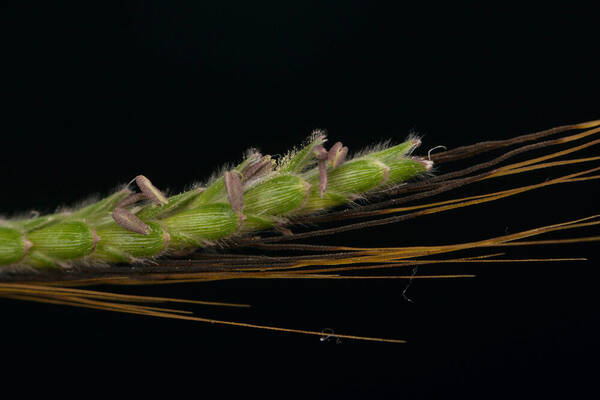Info
Subfamily: Panicoideae
Genus etymology: Dichanthium = "paired flower" [Greek] refering to the difference between the basal homogamous and the other heterogamous spikelets
Species etymology: aristatum = "bristle possessing" [Latin] refering to the awns
Photosynthetic type: C4 (warm season)
Nativity: naturalized - intentional
First recorded in Hawaiʻi: 1911
Map


Inflorescence





Plant


Habit



Spikelets





Node

Peduncle of inflorescence

Description
Plants perennial; stoloniferous, stolons often 2 m or longer. Culms 70-100 cm, decumbent, erect portions generally about 35 cm, pubescent beneath the inflorescences; nodes glabrous or densely short pubescent. Sheaths glabrous; ligules 1-1.3 mm; blades 6-25 cm long, 3-6 mm wide, glabrous or hispid. Rames (2)3-5(8), 4-7 cm, subdigitate, erect to divergent, bases pilose, without spikelets; internodes pilose. Sessile spikelets 4-5 mm; lower glumes more or less obovate, often involute, margins ciliate basally, keels winged distally, apices obtuse; awns 1.5-2.5 cm, twice-geniculate. Pedicellate spikelets 4-5 mm, usually staminate. 2n = 20.
(Description source: Barkworth, M.E., Capels, K.M., Long, S. & Piep, M.B. (eds.) 2003. Flora of North America, north of Mexico. Volume 25. Magnoliophyta: Commelinidae (in part): Poaceae, Part 2. Oxford University Press, New York. 783 pp http://floranorthamerica.org/Dichanthium_aristatum )
Annuals; culms solitary or few, some- times numerous, forming large perennial clumps resulting from reseeding, 3-40 cm tall. Sheaths glabrous, open to base; ligule membranous, triangular, 4-5 mm long, apex entire but becoming lacerate; blades filiform or subsetaceous, usually 1-5 cm long, up to 1 mm wide. Inflorescences pa- niculate, loose, ovate to oblong, 1-12 cm long, the branches bare at base; spikelets 2, ca. 3 mm long, clustered toward tips of capillary branches, pedicels 0.7-3.5 times as long as the spikelet and pear-shaped at apex; glumes pale brown, chartaceous, Ovate, 2.3-3.5 mm long, enclosing the florets, nerves + prominent, surface lustrous, glabrous except sparsely scabrous along keel, apex acute, slightly erose; lemmas dark reddish brown, narrowly ovate, 2-2.5 mm long, short-scabrous, apex acuminate, 2-lobed, apical teeth setaceous, awn 3-4 mm long, slightly geniculate, inserted below midpoint on dorsal face, rarely absent, callus minutely bearded at lateral margins of floret; palea similar in color, vestiture, and texture to lemma, 1.5- 2 mm long, apex acuminate, somewhat adnate to caryopsis. Caryopsis 1-1.5 mm long, ca. 0.5 mm in diameter, weakly adnate to lemma and palea and remaining enclosed within them. [2n = 14, 28.]
(Description source: O’Connor, P.J. 1990. Poaceae, pp. 1481–1604. In: Wagner W.L., Herbst D.R. & Sohmer S.H. (eds.)., Manual of the flowering plant of Hawaiʻi. Vol. 2. University of Hawaii Press & Bishop Museum Press, Honolulu )